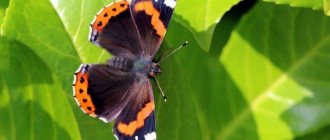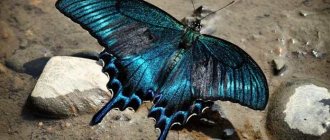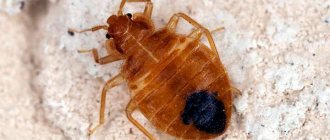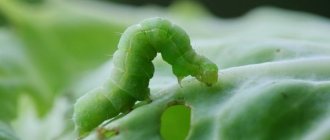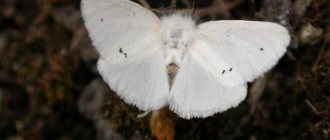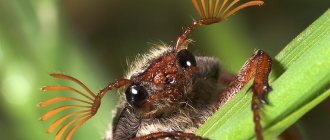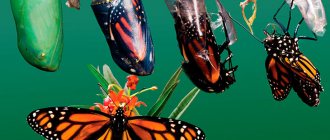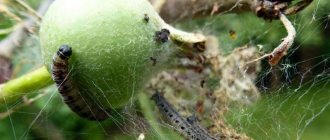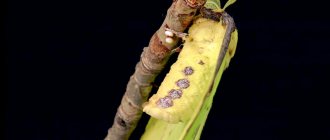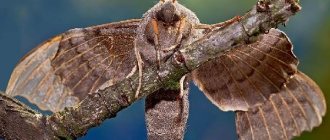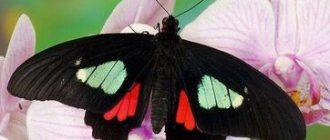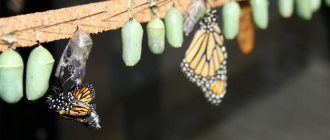Get ready for a journey into the colorful world of insects! You will see unusual butterflies and caterpillars common in the Moscow region, learn to identify them by their external signs and simply get aesthetic pleasure!
When we talk about the benefits of butterflies, we most often mean the properties of adult individuals. Thus, these insects are able to pollinate plants and attract birds to the garden. And if we mention harm, then here we are talking about the caterpillar stage, when the insect actively feeds on plants and can harm garden plantings. The butterflies themselves feed on nectar and are absolutely safe for plant health. Therefore, we will agree in advance that when we call a butterfly “harmful,” we mean its caterpillars.
Now let's take a closer look at the most common fluttering insects that you can find on your site, and determine which of them are useful and which are harmful!
Admiral - butterfly with stripes
Vanessa atalanta, wingspan 50-65 mm
The admiral is easy to recognize: there are red stripes on both sides of his wings. According to one version, it was thanks to this color that the butterfly got its name, because Russian admirals used to have ribbons over their shoulders and red stripes on their trousers. The lower wings of the insect are also decorated with red stripes, on which black dots are clearly visible. The edges of the wings are wavy.
You can meet such a beautiful butterfly not only in Russia, but also in North Africa, North America and even New Zealand. The admiral usually goes to southern countries to spend the winter, but sometimes hides under the bark of trees and remains there until spring. Previously, the admiral was included in the Red Book of Russia, but now the population has recovered.
animalreader.ru
It is not so easy to recognize the admiral's caterpillar as a future butterfly. Dark color, yellow dots on the sides of the body and frightening spikes - the insect is perfectly protected from birds and knows how to camouflage itself. It can be found from May to August on the leaves of nettles, hops and thistles.
How to attract an admiral butterfly. The Admiral loves thistles, asters and blackberries, and at the end of the season he is not averse to eating cracked plums and pears, especially if they have fermented. Place some fruit in a bowl and butterflies will flock to the smell. And to see the caterpillars, plant nettles on the site, which will also be useful as plant food.
The ancient Indians believed that if you catch a butterfly, whisper a cherished wish to it and release it into the wild, it will certainly come true. Try it!
Saturnia Maya / Hemileuca maia
In the photo you can see what the caterpillar of a beautiful butterfly looks like. But the larva disgusts her and discourages her from getting to know each other better.
The entire body is covered with hollow spines, which are connected to poisonous reservoirs. When examined under a microscope, you can see that these spines are covered with multiple hairs. They themselves are dark, but the caterpillar's body is light.
The poison causes severe itching and burning in the victim. After the initial external symptoms, headache and nausea begin. From spring to mid-summer they sit in large groups on oak branches and willows.
13
Hawthorn - beautiful and treacherous
Aporia crataegi, wingspan 50-65 mm
Hawthorn can often be found in gardens in the Moscow region. This beautiful butterfly with white wings decorated with black veins flies from apple tree to rosehip, from rowan to plum, from grape to pear to lay its eggs, from which voracious caterpillars will soon emerge. Hawthorn is a “relative” of the famous cabbage. Prefers wetlands and easily travels long distances in search of food and nesting sites.
nature.baikal.ru
Hawthorn caterpillars are covered with thick hairs and can gnaw an entire bush or tree in a short time. They grow slowly, so they make nests in trees for the winter. If leaves entangled with mulberry threads appear on the branches, rest assured that the hawthorn has settled in your garden!
How to deal with hawthorn and its caterpillars. You can place hunting belts on trees and put up birdhouses to attract birds. In early spring, it is worth spraying the plants with a solution of copper sulfate (100 g per 10 liters of water) with the addition of 500 g of urea. If there are a lot of pests, use insecticides: Alatar, Fatrin, Kinmiks, etc. Carry out the treatment during bud break, when the caterpillars emerge from their winter nests, or in the summer after the caterpillars hatch from their eggs.
Subspecies
- Cossus cossus cossus
- Cossus cossus albescens
Kitt, 1925 (Kazakhstan, Russia) - Cossus cossus araraticus
Teich, 1896 (Azerbaijan, Georgia, Turkey, Iran) - Cossus cossus armeniacus
Rothschild, 1912 (Turkey) - Cossus cossus chinensis
Rothschild, 1912 (China: Shaanxi) - Cossus cossus dauricus
Yakovlev, 2007 (Russia: Transbaikalia) - Cossus cossus dersu
Yakovlev, 2009 (Russia: Primorsky Krai) - Cossus cossus deserta
Daniel, 1953 (Mongolia) - Cossus cossus gueruenensis
Friedel, 1977 (Asia Minor) - Cossus cossus kopetdaghi
Yakovlev, 2009 (Turkmenistan) - Cossus cossus kossai
Wiltshire, 1957 (Jordan, Iraq) - Cossus cossus lucifer
Grum-Grshimailo, 1891 (Tibet) - Cossus cossus mongolicus
Erschoff, 1882 (Mongolia) - Cossus cossus omrana
Wiltshire, 1957 (Iraq, Iran) - Cossus cossus tianshanus
Hua, Chou, Fang & Chen, 1990 (Kazakhstan, Kyrgyzstan, Uzbekistan, Tajikistan, Afghanistan) - Cossus cossus uralicus
Seitz, 1912 (Uralsk)
Cabbage is a dangerous pest of cabbage heads
Pieris brassicae, wingspan – 45-63 mm
Cabbage grass, or cabbage white, is familiar to every summer resident. You can find it in beds with cabbage, turnips, turnips and other cruciferous crops. The butterfly is fussily looking for a place to lay eggs, from which yellow-green caterpillars will soon appear. During the season, one individual lays up to 300 eggs!
Unprepossessing in appearance, the white hare terrifies with its appearance. You should especially be wary of females, the main difference of which is the black spots on the upper wings.
The voracious caterpillars of the white butterfly eat the leaves and prevent the head of cabbage from forming. After a while, only the veins remain from the leaf. When the food runs out, the pests crawl to new plantings.
How to deal with cabbage and its caterpillars. Safe methods include hand-picking caterpillars and catching butterflies. You can also plant marigolds, marigolds, mint or sage between the rows, which will repel pests. A good way is to cover the cabbage with a mosquito net and agro-canvas so that butterflies cannot lay eggs. Folk remedies will help by spraying 2 tbsp. mustard and 1 tsp. ground red pepper per 10 liters of water. And if there are a lot of insects, use Fitoverm, Karbofos, Actellik or another insecticide.
Penetration methods
As mentioned earlier, caterpillars can enter the apartment along with food in the kitchen. However, in addition to this, pests can be seen in other parts of the house.
- If the owner finds white caterpillars with a yellow tint in his apartment, then most likely furniture moth larvae have infested the furniture. They can also be detected by their fabric cocoons, which contain small white balls that look like dark rice. These insects can enter the house with purchased furniture. If the warehouses had unsanitary conditions suitable for insect life, then the larvae “came” to the house from there. The maturation stage of furniture moths is 3 months. The larvae grow at temperatures from 20 to 25 degrees. Apartment owners may not know about new neighbors for a long time, so when purchasing furniture you should carefully check the interior upholstery.
- Also, with the purchase of furniture, flea larvae can enter the house. They are not terrible for people, since they feed on dead human tissue, hair or synthetic fabric, which is a lot of furniture. When fleas grow up, they become dangerous to humans because they begin to drink blood. They can also be brought into the house with vegetables and pet products (rugs, bedding). If the house is old, then the larvae like to hang around in wooden planks.
- Pests are found in new mattresses and pillows. Clothes moth larvae look like small white worms with 6 pairs of legs. They can be identified by the silk case in which they live. They feed on the remains that humans leave behind: sweat, greasy food stains, hair.
- Carpet beetle caterpillars can get into your home with new carpet. Their elongated body has alternating brown and golden stripes. These larvae are found in clothing and pillow feathers.
- You should not take old furniture from your hands. If necessary, the boards should be checked. Caterpillars of grinder beetles can live in them. They live in the same furniture for about 20 years. They are very harmful to wooden materials and can then climb into other furniture. The larva is distinguished by its gray, fleshy body with spines on its head. Over the course of its entire life, this insect can chew through 50 km of wood.
- Due to dampness in the toilet and bathroom, silverfish larvae settle on the ceiling and walls. They have a white or silver body with a black shell. They don't like light, so they prefer the gaps between baseboards. Such insects live for 4 years and reproduce very quickly.
- If the kitchen is not clean, in addition to food moths, fly caterpillars may appear. They look like white worms. They are very dangerous because they spread infections. You should get rid of such neighbors immediately after discovering them.
Urticaria - a connoisseur of birch sap
Aglais urticae, wingspan – up to 50 mm
You've probably seen this butterfly more than once, but you couldn't even imagine that the offspring of this luxurious beauty feed on stinging nettles! A special sign of urticaria is large black spots on dark orange wings. The hind wings are covered with small blue spots. The insect feeds on nectar of various flowers, and also does not refuse birch sap.
nasekomus.ru
One clutch of wren can contain up to 150 eggs, from which black, hairy caterpillars emerge. They gradually begin to eat the nettles, and at its top they build a nest of cobwebs for shelter from bad weather. After numerous molts, the caterpillar becomes yellow-black and is ready to pupate.
How to attract hives. The answer is obvious - plant nettles! But if you don’t want to see this weed in your summer cottage, try pouring a little birch sap into flat containers to attract insects. And plant lavender, oregano, echinacea, David's buddleia, spirea, bird cherry and other aromatic plants in your flower beds.
- What to plant in a flower garden to fill the garden with an unforgettable aroma
Do you want to plant fragrant flowers on your property? Then take a look at our selection!
Purple Hawkmoth / Mimas tiliae
The small caterpillar reaches an average length of no more than 6 cm at the peak of development. The species of this inconspicuous butterfly was discovered by Carl Linnaeus in 1758.
The body is rough, and there is a horn on the tail. This horny process has a protective shield. Development begins in early summer. During this period, they can be found on the branches of wild and fruit trees. There are especially many of them on linden, birch, and various types of alder. By the time of pupation, the body color completely changes.
It is not dangerous in itself, but if it crawls across the body, it will leave a bright mark. There are substances on her body that cause an allergic reaction. It is most difficult for allergy sufferers and people with weakened immune systems.
9
Willow ribbonwort - twilight guest
freenatureimages.eu. Catocala electa, wingspan – 65-88 mm
The second name of this butterfly is willow ribbon. The insect leads a crepuscular lifestyle, so you are unlikely to see it during the day. The butterfly's front wings are gray and inconspicuous, but the lower wings are bright red with black edging and spots in the middle. Moreover, in males the raspberry shade predominates, and in females it is red. The Ribbonwort can also be seen in the fall. It is most often found near bodies of water, in meadows and wetlands. It feeds on tree sap.
pyrgus.de
Caterpillars of the willow tapeworm are perfectly camouflaged. The yellow-gray body is covered with small black dots, the head is brown. The insect feeds on willow and poplar leaves, so it does not harm garden crops. But if you have a willow growing on your site, be vigilant.
How to attract a ribbon girl. It would seem that the insect is nocturnal - why attract it? You can do this at least just to see this amazing butterfly. In the evening, turn on a flashlight or other artificial light source - and the ribbon fly will come to visit you.
Baang haang
This is the name of the caterpillars of Thailand. We will complete our list of most-beauty with them. Almost all caterpillars of an exotic country will cause a lot of problems for tourists. After meeting them, the body itches for weeks and a rash appears.
Like many inhabitants of tropical forests, the larvae of Thai butterflies are beautiful and distinctive. Most species are brightly colored to scare off enemies. Some, on the contrary, disguise themselves as foliage or the earth's surface.
When going to any country, you need to study what dangerous creatures you can encounter in its open spaces.
Lemongrass is a long-liver in the world of butterflies
Gonepteryx rhamni, wingspan – 52-60 mm
Lemongrass, or buckthorn, is a rather inconspicuous-looking butterfly from the white butterfly family. Small dots are placed in the center of its wings, and the wings themselves imitate the shape of leaves on a tree. Nature has done its best so that these insects can hide from their enemies!
Males have a richer wing color than females. In the latter, the color of the wings is predominantly greenish-white. The development cycle of one individual takes about a year, which is a rare phenomenon in the world of butterflies. Therefore, lemongrass can safely be called a long-liver.
macroid.ru
Lemongrass lays 1-2 eggs on buckthorn leaves. Then green, smooth, slightly flattened caterpillars appear. Despite their great appetite and fastidiousness, insects do not cause much harm to trees.
How to attract lemongrass. Mostly butterflies feed on the nectar of dandelion, meadow cornflower, thistle, but they will not refuse cultivated plants. It is better to fight weeds that attract lemongrass in your summer cottage.
- How to get rid of weeds - the secrets of “clean” beds
Weed control is the main headache of all summer residents. Let’s figure it out together how to suppress the growth of weeds effectively and easily.
Nutrition
Hairy caterpillars in most cases eat plant foods - juices of fruits, plants, nectar. However, among them there are predators that eat their own kind - weakened, diseased larvae, butterflies, other small insects, and aphids.
- Polyphages are absolutely indiscriminate in their food, eating almost all vegetation. They lead a predominantly nocturnal lifestyle.
- Oligophages eat plants of a certain species or genus. Thus, the caterpillar of the swallowtail butterfly feeds exclusively on umbrellas.
- Monophages live and eat one plant. If a particular shrub is heavily infested, other plant species adjacent to it remain completely safe.
- Xylophages do not eat anything except wood. This group of caterpillars is always distinguished by a large number of individuals in one brood.
The transitional form is furry creatures that eat tinder fungi and lichens. A separate group includes keratophages, which feed on elements of animal origin - horny cover, wool, skin, hair.
Furry caterpillars
The hairy caterpillar butterfly is an ancient inhabitant of our planet, whose roots go back to the time of dinosaurs. There is a huge variety of larvae in the world, distinguished by their unusual appearance and the presence of body hairs of different lengths. A photo of the furry caterpillar is presented below.
The furry caterpillar may look quite attractive, but you should not touch it out of curiosity. In most cases, the hairs contain a special poison, which, when it comes into contact with the skin or wound, causes serious irritation of the skin, deterioration of general health - headache, chills, nausea, dizziness, etc.
Malinnitsa is a modest record holder
commons.wikimedia.org by Charles J Sharp. Callophrys rubi, wingspan 26-28 mm
The raspberry and the raspberry blueberry are the same butterfly from the genus Greenfinch. It is not easy to notice it, because... the outside of the insect is brown and the inside is green. In addition, the butterfly is small and almost always keeps its wings folded for camouflage. You can meet her not only at the dacha, where she flies for flower nectar, but also in swamps and meadows. Raspberries are common in the temperate zone of Eurasia. The butterfly's habitat reaches the Polar Urals, and in the Alps it sometimes rises to a height of up to 1800 m!
insectamo.ru, author: Ponomarev A. G.
Raspberry caterpillars have a fairly rich “menu”, which includes leaves of blueberry, heather, birch, gorse, buckthorn and other plants. What about raspberries, you ask? Alas, raspberry caterpillars really will not refuse raspberry and currant leaves. But despite their food preferences, they are rare on these plants. Insects are sensitive to chemicals, so they prefer to stay away from summer cottages. In addition, this species is quite rare in nature.
Some blueberry caterpillars are able to pass themselves off as ant larvae. As a result, the ants feed the caterpillars, and the latter, without hesitation, also eat the eggs and larvae of their benefactors.
How to attract raspberries. The raspberry tree is not one of those butterflies that will circle brightly over a flower bed. But if you have clover, sweet peas or vetch, she may come briefly to collect sweet nectar.
Reasons for the appearance of caterpillars in an apartment or private house
Insect caterpillars emerge only from larvae. If moth eggs were found in the house, it means that an adult moth entered the house through a window or doorway. This species loves damp places, so if the ceiling leaks a little, the moth will definitely settle on it.
Also, people themselves can often bring larvae into the apartment without noticing it. Caterpillars live in cereals, walnuts or candies. They also live in flour or dried fruits. Food products are susceptible to contamination due to poor processing or long shelf life.
The reason for the appearance of caterpillars is favorable conditions for reproduction and living. In addition to ceilings, caterpillars live in beds and sofas filled with fabric. It is important to quickly get rid of parasites, otherwise they will multiply at high speed.
Swallowtail - Queen of Butterflies
Papilio machaon, wingspan – 64-95 cm
It’s hard not to notice such a butterfly! Swallowtail attracts attention with its large size and bright color. The butterfly got its name from the name of a mythological doctor who participated in the Trojan War. A special feature of the swallowtail is the “tails” up to 10 mm in length on the hind wings.
Swallowtail is found all over the world: in Europe, Asia, North America and North Africa. The butterfly population in the middle zone suffers from fires and trampling of meadows. The species is listed in the Moscow Red Book.
The bright swallowtail caterpillars resemble fantastic creatures. Immediately after birth, they begin to feed. In the Moscow region, insects prefer umbrella crops: hogweed, carrots, parsley, fennel and dill. If a caterpillar gets into a garden bed, it can quickly destroy the above-ground parts of the plants. But this happens extremely rarely, because... The swallowtail practically does not fly to summer cottages.
How to deal with swallowtail caterpillars. Carefully remove them and take them outside the site, planting them on some kind of umbrella crop. Be careful, the “horns” of the caterpillars secrete a caustic liquid, so it is better not to pick up the insect with your hands, but tear it off along with a piece of the plant on which it sits.
What do caterpillars eat?
The hatched caterpillar first devours the shell of the egg in which it developed, and then proceeds to its main diet.
Most caterpillars are herbivores (phytophages) and feed on green mass and fruits of plants. According to the food supply, caterpillars are divided into 4 types:
- polyphagous - indiscriminate caterpillars that eat any vegetation, for example, the caterpillars of most moths;
- oligophages prefer plants of a certain family or genus. For example, swallowtail caterpillars eat only umbrella plants;
- Monophages consume a single type of vegetation. Thus, silkworm caterpillars feed only on mulberry leaves;
- xylophages do not eat anything except wood, and constitute a small variety of caterpillars - mainly glass beetles and wood borers.
The transitional form is considered to be a variety of caterpillars that eat lichens and tinder fungi. This category includes representatives of the genus of true moths. For example, the granary moth caterpillar thrives on poisonous ergot.
A few species of caterpillars are keratophagous by nature and eat elements of animal origin: horny substance, hair, wool and skin. Prominent examples are the caterpillars of furniture, carpet and clothes moths. Caterpillars of true moths eat only wax, and bee moths eat honey.
Predatory caterpillars are the smallest group: most cases of predation occur when the population density is high and there is a lack of usual food. For example, cotton bollworm and bear moth caterpillars are carnivorous and attack their own kind, weakened and diseased caterpillars.
Caterpillars of the narrow-snouted and raspberry moths, as well as the sun moth, which feed on scale insects, are considered natural predators. Predatory blueberry caterpillars eat aphids, and moth caterpillars are exclusively insectivorous and are distinguished by a rich set of hunting devices for catching their victims.
There are species of caterpillars that live in symbiosis with ants - for example, some varieties of blueberries. These caterpillars live in the anthill and control the behavior of ants by chemical means, secreting a special sweet liquid, or by acoustic means, making special sounds that attract ants.
back to contents
Peacock's eye - the most picturesque butterfly of the middle zone
Aglais io, wingspan up to 62 mm
This butterfly will not leave any summer resident indifferent! The insect will decorate any flower garden and its offspring will not cause any harm to the garden. The round spots on the front and hind wings of the butterfly are very reminiscent of the spots on the tail of a peacock. With the help of such a cunning device, the peacock's eye often confuses birds that would like to feast on the butterfly.
dic.academic.ru
The peacock eye caterpillar is not so noticeable, although its black spines can also scare off enemies. Black caterpillars live in large colonies of up to several dozen individuals. They mainly prefer to eat nettles, thistles or hops, and less often – willow and raspberries.
How to attract a peacock eye. These butterflies are excellent pollinators. To attract them to the garden, plant flowers in shades of red, pink, orange or yellow in your flower bed. And also plant some nettles in the area.
How to control peacock eye caterpillars. An invasion of caterpillars can damage the raspberry tree, but if in the spring you treated the plantings with insecticides as standard, do not worry about the safety of the crop. It is easier to remove pest colonies manually.
Ursa Hebe
This species lives in the steppe zone and has a wide distribution area. Butterflies are found in central and southern Europe, Transcaucasia, Asia Minor, Mongolia, China and many other countries. On the territory of Russia, individuals can be found in Siberia, the Caucasus, Crimea, Central Asia and Kazakhstan.
Outwardly, it is a black caterpillar, on the body of which there is a large number of long dark gray hairs. On the sides these fibers have a more orange tint. They feed on dandelions, plantain, milkweed, millennial, and thyme.
Thus, the caterpillars of butterflies of the bear family are characterized by an unusual appearance, which helps them camouflage in different territories. To protect the caterpillars there are poisonous fibers. This allowed the individuals to maintain their populations. For agriculture, the gluttony of caterpillars poses a real danger and requires the use of additional measures to prevent eating crops.
Mother of pearl - the enemy of apple trees, blackberries and raspberries
Argynnis paphia, wingspan up to 75 mm
The pearlwort is a fairly large daytime butterfly with an unusual spotted color. The name of the insect was given because of the iridescent greenish-silver spots by which butterflies recognize individuals of their species. In warm weather, you can see flocks of pearlworts busily flying over the flower beds. These lepidopterans are also found along roadsides, in clearings and near rivers. There are many subspecies of Argynnis paphia, each of which feeds on specific crops.
molbiol.ru
Most often found in the country are large mother of pearl. Food plants for its caterpillars are apple trees, blackberries, raspberries, and violets. The body of the larvae is covered with many villi.
How to deal with mother of pearl and its caterpillars. There are different ways to protect plants from caterpillars. The simplest is to install trapping belts or pheromone traps and inspect them regularly. Regular removal of curled leaves and attracting birds will also help. It is better to choose biological drugs: Fitoverm, Bitobaxibacillin, Entobacterin, etc.
Pine silkworm / Thaumetopoea pinivor
In Russia, poisonous caterpillars are not as dangerous as those in South America, but they can also cause a lot of trouble.
This type of silkworm received its name due to the massive migrations of larvae. They live on pine needles, which they feed on. During development, lush hair appears on the body. Adult individuals break these hairs themselves, resulting in the formation of a kind of dust. When such dust gets on the mucous areas and skin of a person, a strong burning sensation begins.
Then the skin turns red and severe itching begins. Symptoms appear within a few weeks. After contact, you should seek medical help.
Meadow pestle is a poisonous insect
Zygaenidae, wingspan 16-38 mm
Groups of pests often flutter over flower beds in sunny weather. Insects are easy to recognize: they have rounded red spots on their dark blue or green wings. In addition, unlike other butterflies, the wings of the meadow moth are folded like a roof, like those of moths. If a butterfly is caught, it will begin to secrete repellent foam. In nature, no one hunts a butterfly. It is poisonous and itself very resistant to poisons.
Caterpillars of moths are densely covered with warts, from which small bristles protrude. Body color: yellow-green with a scattering of black spots. Caterpillars can also secrete protective substances, so it is better not to handle insects with your bare hands. They feed mainly on clover and grasshoppers.
How to attract meadow moth. Plant clover, plantain, alfalfa or thyme in the area. The butterfly will also be happy with the dandelion, but usually, on the contrary, they try to remove it from the site.
- How to get rid of dandelions on your property - useful tips for summer residents
Dandelions feel great in your area and threaten to “take over” it completely? Fight the weeds!
Saturnia io / Automeris io
The beautiful peacock butterfly is found in Canada and the United States. The entire body of the caterpillar of this butterfly is covered with peculiar greenish thorny pom-poms.
She herself is light, and does not grow more than 4–5 cm. You can only admire this view from afar, but under no circumstances pick it up or even touch it. After contact with the thorns, poison penetrates the body. Toxic substances cause redness, pain at the injection site and can even cause the development of dermatitis.
It looks like a very cute and safe creature. But this is yet another proof that beauty is deceptive.
10
Burdock - a lover of overseas travel
Vanessa cardui, wingspan 47-65 mm
The burdock butterfly, or thistle, is often confused with the urticaria. They are really similar, but, unlike the urticaria, the burdock is much larger and has black, rather than blue, spots on its hind wings. The number of this species varies from year to year. For example, in 2009 there were especially many of them. For the winter, burdocks fly to North Africa, and then return to the European continent and begin breeding.
wallhere.com
Females lay one egg each on thistle, burdock, coltsfoot, yarrow or nettle. After hatching, the caterpillar makes a shelter out of leaves. Over the course of her life, she can change at least 7 of them. Depending on the food plant, the color of the caterpillars will also change. At the dacha, they will help fight weeds and become food for birds.
In the southern regions of Russia, burdock caterpillars can infect tomatoes, eggplants, soybeans, and melons.
How to attract a burdock. Plant cosmos, asters, saplings, David's buddleia, phlox and other plants attractive to butterflies in your flower beds. Thickets of thistles near the site will also attract the attention of thistles.
Lonomia / Lonomia Obliqua
One of the most poisonous caterpillars on the planet is the larva of the Peacock butterfly, found in Latin America. Reaches a length of 5.5 to 8 cm. The entire body is covered with fine hairs. They are also called the Lazy Clown.
Numerous studies have proven that lomonia can produce toxic substances dangerous to human life and health. For the first time, attention was paid to toxin poisoning in 1983, when dangerous creatures caused a massive epidemic in the Brazilian state of Rio Grande do Sul.
A poisonous caterpillar from South America has caused the death of many people. Fatal outcomes after encountering it are recorded especially often in the south of Brazil.
14
Prevention measures
To prevent woodworm from appearing in the garden area, it is best to take preventive measures. They consist of regularly clearing trees of moss and cracked bark. To preserve trees, you will need to lubricate the trunk using any of the following mixtures:
- Mix clay (2 parts) with lime (1 part).
- Prepare a product from insecticide, glue and clay. To do this, dilute the clay in a bucket with water to such a consistency that it resembles sour cream. Then add 10% Karbofos and 250 g of carpentry or casein glue. If the trees are young and their bark is very thin, you should not add glue.
The selected mixture should be used on days when there is no rain. The frequency of application is twice per season: in the spring, when there is still snow cover, and in the fall, after the leaves have fallen. It is necessary to coat not only the tree trunk with the mixture, but also the base of the branches. Coating height is 2 m or more.
Notes
- Vorontsov A.I. Forest entomology. — 4th ed., revised. and additional.. - M.: Higher School, 1982. - 384 p.
- Mirzoyan S. A., Batiashvili I. D., Gramma V. N. et al. Rare insects M.: Forest industry, 1982. - 165 p.
- ↑ 12
Shevyrev I. Ya. Scented woodborer // Encyclopedic Dictionary of Brockhaus and Efron: in 86 volumes (82 volumes and 4 additional). - St. Petersburg, 1890-1907. - Striganova B. R., Zakharov A. A. Five-language dictionary of animal names: Insects (Latin-Russian-English-German-French) / Ed. Doctor of Biology sciences, prof. B. R. Striganova. - M.: RUSSO, 2000. - P. 200. - 1060 copies. — ISBN 5-88721-162-8.
- Krushen-woodborer // Encyclopedic Dictionary of Brockhaus and Efron: in 86 volumes (82 volumes and 4 additional). - St. Petersburg, 1890-1907.
- Vasiliev V.P. Pests of agricultural crops and forest plantations: In 3 volumes - Vol. 2. Harmful arthropods, vertebrates. — 2nd ed., rev. and additional / Under the general ed. V. P. Vasilyeva; Editors of the volume V. G. Dolin, V. N. Stovbchaty. - K.: Urozhay, 1988 576.
- Scarlato O. A. Key to insects of the European part of the USSR. Volume IV. Lepidoptera. First part. A. K. Zagulyaev, V. I. Kuznetsov, A. A. Stekolnikov, I. L. Sukhareva, M. I. Falkovich. L., “Science”, 1978, 712 p.
- Butterfly pests of agriculture and forestry in the Far East: Key. Ed. Belyaev E. A. et al. Vladivostok: Far Eastern Branch of the USSR Academy of Sciences, 1988
Ochrogaster lunifer
This type of caterpillar is called "hiding in a bag." They stay in groups in a silk bag during the day, and at night they crawl out to hunt, moving one after another.
The species lives in South America and poses a danger to humans. The black caterpillar is completely covered with sharp hairs. They are not poisonous, but touching them can cause a deep cut.
The whole danger is that these hairs act as a powerful anticoagulant. This substance slows down the process of blood clotting. To avoid big problems, it is necessary to provide medical assistance.
Habitat
Most often the caterpillar can be found on the ground, but many representatives have begun to develop under water. For example, the Hawaiian moth caterpillar has spread on land and in water.
Caterpillars are also divided into two types, according to which they lead either a secretive or free lifestyle. Caterpillars, which lead a free lifestyle, live on the foliage of plants and are large in size. Secretive caterpillars include a number of varieties:
Witch moth / Phobetron pithecium
The most peculiar and unusual caterpillar in wildlife usually lives on fruit trees in orchards. Because of its unusual appearance, it is also called the “slug monkey.”
The entire body is covered with thick hair, and the body structure differs from the usual physique of butterfly larvae. Most often, the hair is light brown in color, which darkens with age.
Nature took care of protection, because not every bird will decide to peck such a “monster”. This type of larva can be perceived in different ways, but the hairs contain a toxic substance. If it comes into contact with the skin, it causes redness that goes away after a few days.
Literature
- Zagulyaev A.K. Sem. Cossidae - Woodworms or cossids. / Insects and mites are pests of agricultural crops. T. 3, part 1. Lepidoptera. - St. Petersburg: Nauka, 1994. pp. 47-51.
- Rudnev D.F. Woodworm family - Cossidae. / Arthropod pests of agricultural crops and forest plantations (ed. Vasilyev V.P.). T. 2. - Kyiv: Harvest, 1974. P. 226-228.
- Savkovsky P. P. Atlas of pests of fruit and berry crops. - Kyiv: Harvest, 1976. 207 p.
- Chistyakov Yu. A. Woodworm family - Cossidae. / Butterflies are pests of agriculture in the Far East. Determinant (ed. Kirpichnikova V. A., Ler P. A.). - Vladivostok: Far Eastern Branch of the USSR Academy of Sciences, 1988. pp. 55-60.
Volyanka / Orgyia leucostigma
Small butterflies have settled on all continents, and in total there are more than 2,700 species. Particularly large populations are found in the tropical and subtropical zones of Southeast Asia and the African continent.
The caterpillars of many species of mothwort are poisonous. There are hairs on the body that contain a toxic substance. During periods of mass reproduction, such larvae can cause great harm to animals and humans. The poison causes inflammation of the respiratory tract, affects the mucous membrane of the eyes and causes a rash on the skin.
In addition, they are polyphagous and cause great harm to garden crops. They develop both on trees and on shrubs and herbaceous plants.
Parasa indetermina
The larva of the Parasa indetermina butterfly, due to its unusual appearance and ability to burn, received the nickname “Burning Rose”. It grows no more than 2.5 cm, and its range is limited to the North American continent.
She has bright colors and various stripes can be seen on her body. Red and yellow spots. In addition, for protection, it has a number of processes on which there are burning tubercles. When touched, the tips of these tubercles break off, and severe pain and irritation are felt at the point of contact.
It feeds on the leaves of fruit trees, especially often affecting various varieties of apple trees. Also found in deciduous forests.
By the way, on our website most-beauty.ru there is an interesting article about the most beautiful butterflies in the world.
Coquette / Megalopyge opercularis
When you see such a creature in nature, you might not immediately guess that it is a caterpillar. The larva, covered with a kind of fur, looks more like a furry animal. This is the larva of the flannel moth, native to the southern states of the United States.
But it is not recommended to iron it. Under its hairs are poisonous spines that release a toxic substance when touched. The touch is quite painful, and after about five minutes redness may appear.
This feature is necessary for protection. Attentive nature lovers have noticed that the hairy caterpillar bears a striking resemblance to Donald Trump's hair.
Reproduction of odorous woodworms
The females of these butterflies lay their eggs, as a rule, in the crevices of trees. There can be 700-1000 eggs in a clutch. She lays them in groups of 15-230 pieces. The eggs are oblong, about 1.2-1.7 millimeters long, light brown in color. They are coated with a sticky substance that hardens when exposed to air.
Willow borer caterpillars eat wood. Caterpillars of the first instar are cherry-red or pink in color, while caterpillars of subsequent instars are darker. At the end of development, the size of the caterpillars is 80-120 millimeters. They spend the winter in passages made in wood. They close the entrance to the chamber using drill flour.
The voracious caterpillars of the woodworm eat all the wood that comes in their way.
Caterpillars of the first instar create a common course and stick together. The passages are filled with caterpillar excrement and drill flour. After wintering, each individual gnaws deep into a separate passage, where they develop.
An adult caterpillar makes passages with a peg diameter of 16 millimeters. On trees with thick bark, caterpillars make their burrows only after the first winter, but on trees with smooth, thin bark, they penetrate the wood earlier, most often a month after hatching.
The color of the woodworm serves as an excellent camouflage. It is indistinguishable from wood.
In the northern part of the range, the caterpillars do not emerge from the wood, but make a chamber at the end of their course. In this chamber, the caterpillar constructs a kind of cocoon from drill flour. She spends another winter in it. In spring, adult caterpillars remain in the tree, and in June they emerge from the trunk and turn into pupae in the soil.
A woodworm butterfly emerging from a pupa
Redtail / Calliteara pudibunda
The distribution area of this butterfly is quite wide, but is divided into two large regions. The first, these are the countries of Western Europe, is found in Belarus and Crimea.
The second is the eastern regions of Russia. Widely settled in Siberia and Primorye. It is also called Shy Paw. The entire body of the caterpillar is covered with hairs, and the color is quite varied. There are red, pink, as well as brown and gray individuals. But they all have a small red ponytail at the back.
Touching human skin causes an allergic rash and redness. A furry caterpillar will not do much harm, but it will be unpleasant.
